Today we get the launch of a product line that is a bit fun because it tells us more about Intel. Almost two ago, we covered the Intel Xeon E-2200 series launch. That was an update to the Xeon E-2100 series and when we went from six cores in the entry server market to eight. Today, progress on the core count increase has stalled but we get some significantly better platform features.
Why it tells us a lot about Intel is because of the prioritization. The Intel Xeon E-2300 is based on the Rocket Lake-E platfom that we covered in our Intel Core i9-11900K launch review roughly five months ago and the Intel Xeon W-1300 series that launched four months ago. Now servers get the new architecture, about a quarter after the consumer and professional desktop markets.
Intel Xeon E-2300 Series Launched
The Intel Xeon E-2300 series, based on Rocket Lake-E spans 4-8 cores. We do not get a 10 core option, as we saw with some of the previous-generation desktop parts, but we also do not have dual core offerings anymore. One also gets Intel SGX support, a big feature of the new Intel Xeon Ice Lake processors. These chips only get 512MB support so SGX is on a very limited footprint.
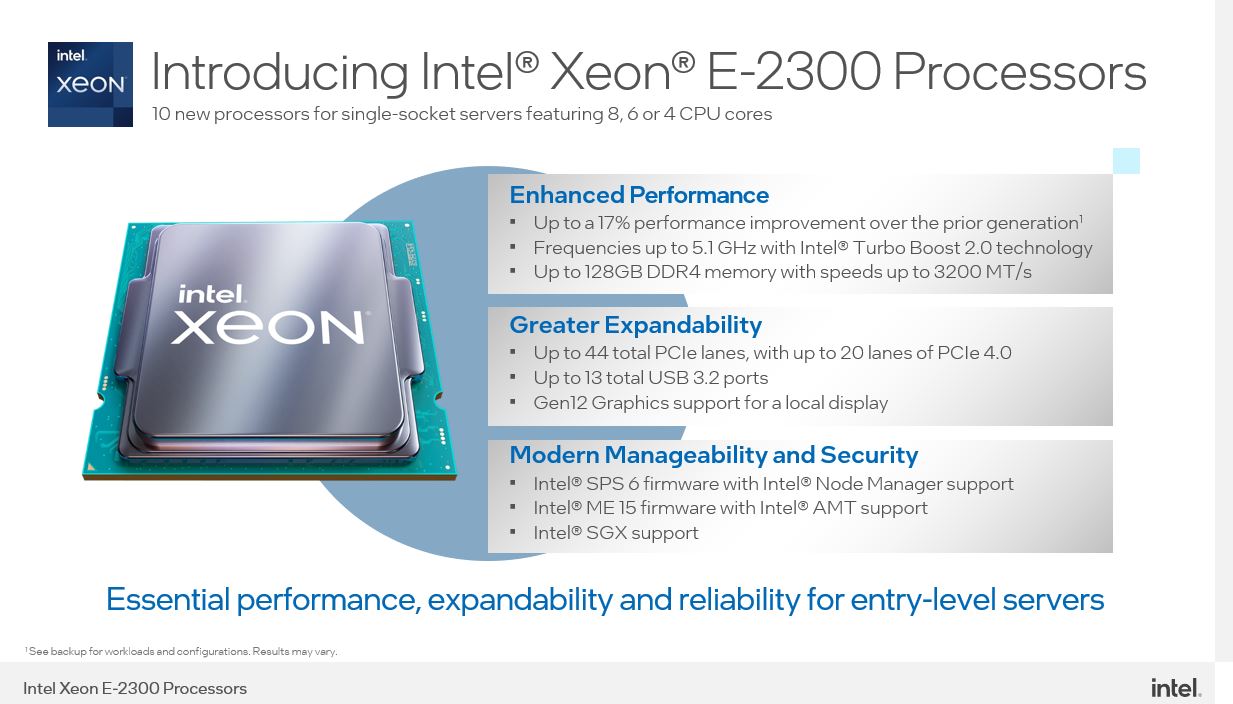
The “Gen12 Graphics support for a local display” line may not make sense to some of our readers. Afterall, this is not the consumer nor the professional workstation series. To answer that, think of an application such as a QNAP NAS where there is a video output that can drive a display for digital signage in a small business envioronment.
For PCIe connectivity we get 20 lanes of PCIe Gen4 for the CPU and then additional PCIe Gen3 lanes (up to 24) on the PCH. Intel doubled the speed of the CPU to PCH to x8 versus x4. Also on the Intel C250 PCH we get SATA III, USB 3.2 Gen2x1 (10Gbps), and USB 3.2 Gen2x2 (20Gbps) ports.
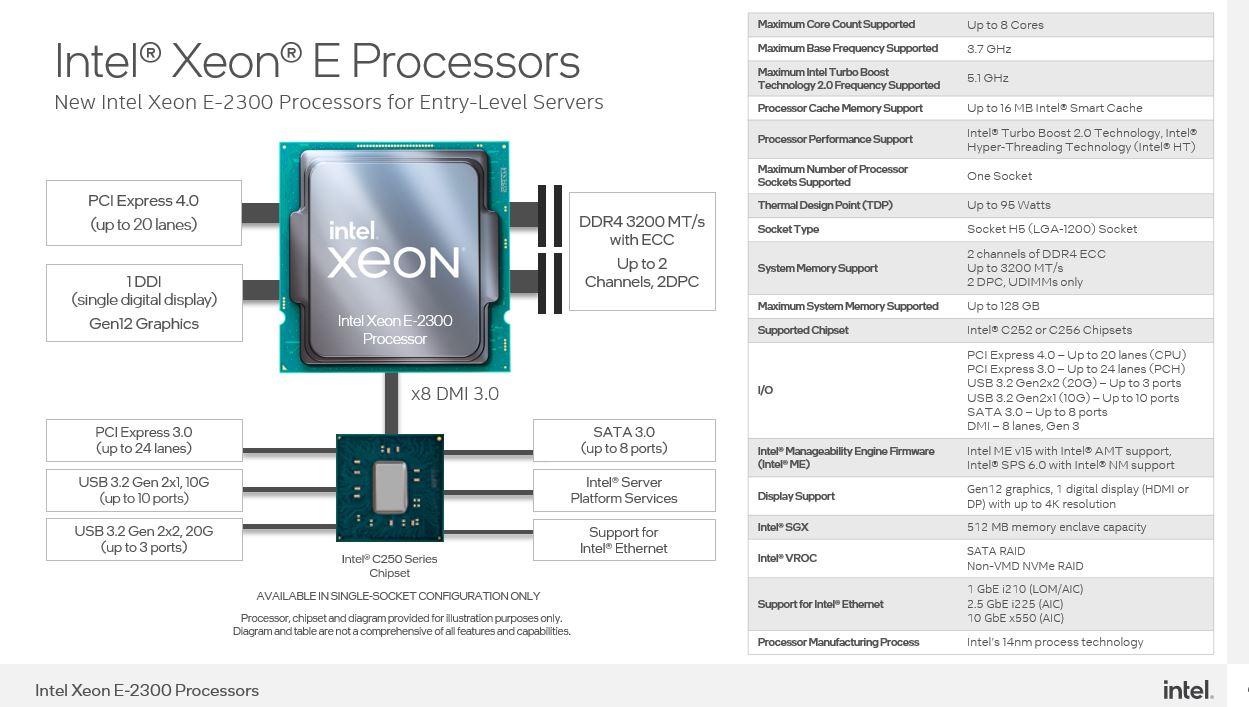
Something we wanted to quickly point out is that the Intel Ethernet situation is different. Intel is listing all of the networking options as AIC for add-in-card. Previously we would have an option for server vendors to use the i219-LM MAC IP for 1GbE conectivity. So “support for Intel Ethernet” in this context may as well be “support for Ethernet” since one can get a similar, or faster solution than what is listed by Intel using either Intel NICs or those from NVIDIA, Broadcom, Marvell, or others.
In this generation we also get dual channel DDR4-3200 unbufered ECC memory support for up to 128GB in 4x 32GB DIMMs.
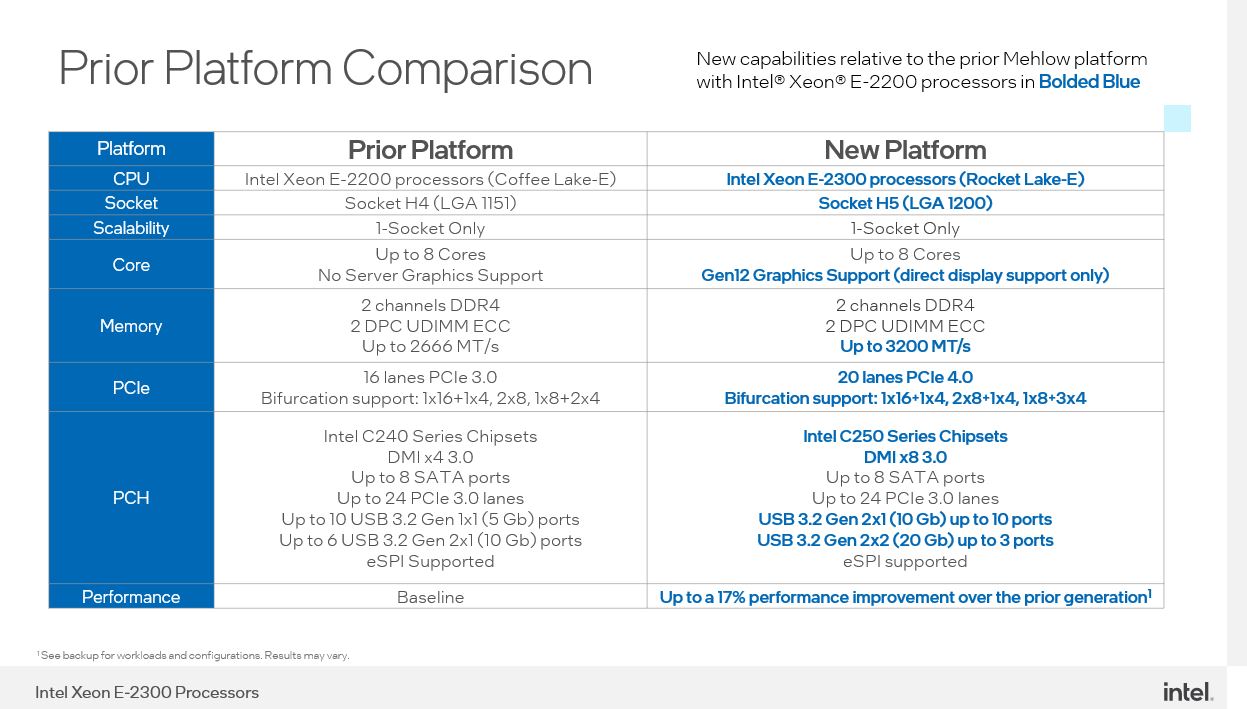
Intel is showing a 17% performance increase. For context, this is two generations of improvement in the mainstream Intel Core architecture, but a single generation in this segment. We also have a new socket, LGA1200.
In terms of SKUs, Intel has ten new SKUs. Six of these have “G” suffixes to make them graphics enabled SKUs. Unfortunately, the bottom two SKUs, the Xeon E-2324G and Xeon E-2314 are four core, non-Hyper-Threading chips that harken back to the same 4 core/ 4 thread configuration we saw in our Intel Xeon E3-1220 review over a decade ago but at a ~20-25% cost decrease, and a massive number of improvements. Still, nothing feels like this is a non-competitive segment more than not incrementing thread counts in more than a decade.
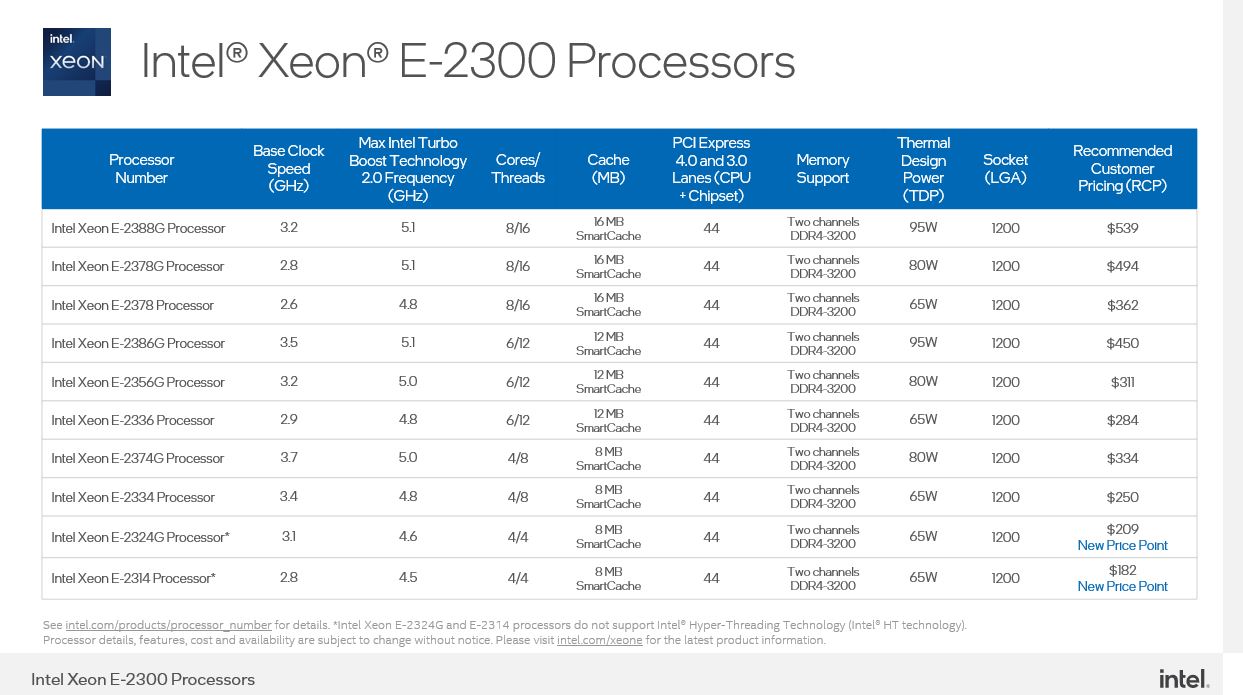
Here it is in the more standard STH format:
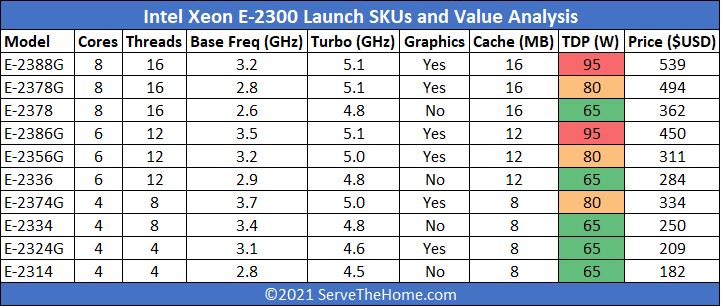
For a quick comparison between this line and the Xeon W-1300 series that uses the same architecture, we have the W-1300 series below. Intel has maintained different firmware and verification for its server chips and workstation parts, but in many ways, one could see the Xeon W parts being replacements in similar form factors.

There is one key difference: TDP. The Intel Xeon E-2300 series is 65-95W TDP while the Xeon W-1300 series is 35-125W. The Xeon W-1300 series also did not launch with any of the 4 core/ 4 thread or 4 core/ 8 thread parts that make up 40% of the Xeon E-2300 series.
Final Words
Bringing PCIe Gen4 to the entry server market is great. Although much of this market is designed with 1GbE networking and maybe a single SATA or NVMe SSD for web hosting and high-frequency EDA workloads, having the ability to do 25GbE/ 100GbE, connect a high-end GPU, or other bits is a great capability.
Looking forward, however, makes this launch feel a bit late. Intel has already started sharing the new Intel Alder Lake Hybrid Processor and Intel Golden Cove Performance x86 Core details building anticipation for the launch. Rocket Lake-E was launched with a lifespan of only a portion of 2021 in the desktop space as it was launched during 2021 and it will be replaced in 2021 by Alder Lake. For the server industry, the lineage of Alder Lake’s hybrid design may end up being a more interesting proposition assuming Linux can properly schedule across cores. Still, the difference is Alder Lake is still not released for the desktop so it is probably not worth pondering that until the next generation is out. Still, that is a challenge with launching a CPU this late in the cycle, even if it is for the server rather than the desktop segment.
If you want to check out more on the previous generation, you can see: Intel Xeon E-2100 and Xeon E-2200 Coverage from STH Your Guide. We will have reviews of the Xeon E-2300 series soon.

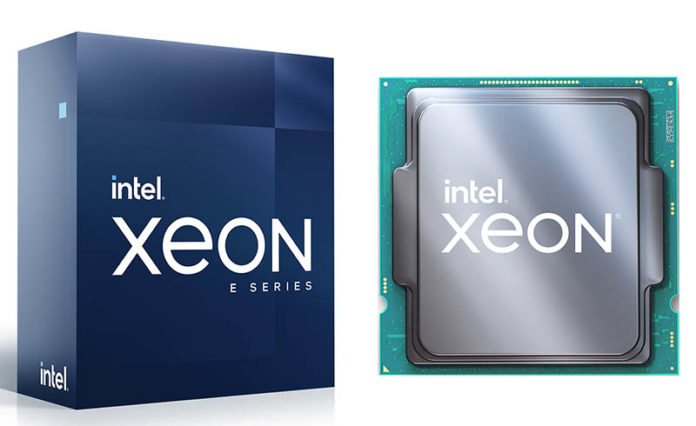
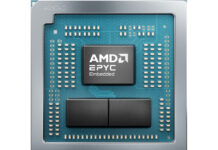
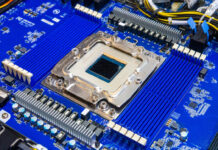
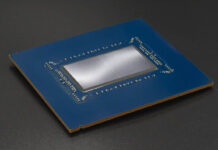
TBH this amount of PCIe IO should be standard on generic desktop.
Wow! Big surprise, but welcome addition to intel market. Just bought E-2226G few weeks ago (6 cores no HT!). Nice chip, no HT, hence no HT-related never ending security troubles and yet just few euros over 4 core 4 threads variant.
So now, let’s look are the available boards…. I guess just smicro is in the business these days, but if Kontron release their semi industrial board update, it may be tempting to update too.
AlderLake for server? No, probably not, I would not hold the breath for this as this looks like pure client solution. Better wait for some Sapphire Rapids spin off with lower core count…
Any C250 series motherboards out/announced? Still low to no availability of Xeon W-1300 series CPUs and mobos
This has the same number of PCI-E lanes as desktop
Looks like (at least thus far) all of the SM Intel Xeon E-2300 based boards will only have 1Gb ethernet. That’s a real shame.
paired with a E3C256D4ID-2T or E3C256D4U-2L2T this seems decent. real shame there is no cheap 8-core with graphics (like the W1370P)… will be staying on my E2146G and see what the winter brings.
@Dr_b_: We have a Xeon-W1370P, and wanted to run it on a Gigabyte W480M Vision W (which officially supports this CPU, if you have the right firmware). We upgraded the firmware using a Comet Lake Celeron (no luck with the Q-Flash Plus feature), neither the Celeron nor the Xeon-W1370P work.
There are no 580-chipset boards in sight, so I wonder whether this Xeon-W will work on C250 boards.